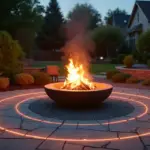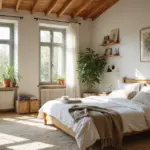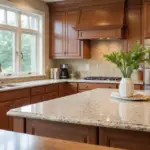Dreaming of a kitchen that’s both beautiful and kind to the planet? Imagine a space where sustainability meets style, where eco-conscious choices enhance your design vision rather than compromise it. From innovative materials to clever design strategies, there are countless ways to create a kitchen that’s as green as it is gorgeous.
Ready to transform your cooking space into an eco-chic haven? Let’s dive into these 20 inspiring ideas that will revolutionize your green kitchen design journey.
1. Embrace Earthy Green Tones
Color psychology tells us that green connects us deeply to nature, growth, and tranquility. Stepping into a kitchen bathed in soft green hues creates an instantly calming and refreshing atmosphere – a welcome respite from daily stress. Different shades evoke different moods; a gentle sage whispers sophistication while a vibrant green injects energy into your culinary hub.

When choosing earthy green tones, look to nature’s palette. Sage, olive, moss, and forest green each bring unique character to your space. These versatile colors pair beautifully with natural wood tones, creams, and whites for a classic look. For something bolder, try accents in terracotta, copper, or brass.
Here’s the catch… green isn’t just visually appealing – it’s been shown to improve concentration and reduce eye strain, making it functionally beneficial in a busy kitchen environment.
2. Install Recycled Glass Countertops
Countertops are crucial both functionally and aesthetically in green kitchen design. Recycled glass options offer a compelling combination of eco-consciousness and chic style. They’re inherently environmentally friendly, giving new life to discarded glass that would otherwise end up in landfills. Beyond their eco-credentials, these countertops are surprisingly durable, holding up well against stains, scratches, and heat.

What really makes recycled glass countertops shine is their uniqueness and customizability. They come in a vast array of colors and textures, and can even incorporate embedded materials, allowing you to create a truly bespoke look. The variety is impressive, ranging from bold chunks of vibrant glass to finely ground options for a more subtle texture.
The game-changer happened as manufacturers began using different binders – cement creates a rustic aesthetic while resin offers vibrant colors and smoother surfaces, giving you plenty of design flexibility in your green kitchen design.
3. Invest in Energy Star Appliances
Kitchen appliances are essential for modern living, but they can be significant energy consumers. Choosing Energy Star certified appliances dramatically reduces your kitchen’s environmental footprint while saving money long-term. The Energy Star label, awarded by the EPA, signifies appliances that meet strict efficiency guidelines, using significantly less energy than standard models.

You’ll find Energy Star certification on refrigerators, dishwashers, ovens, freezers, and even some microwaves. Replacing older models with these certified versions offers the most significant energy savings. The EPA estimates that Energy Star appliances can save hundreds of dollars over their lifetime – an Energy Star refrigerator alone could save you up to $200 compared to a standard model.
Think of it as… every Energy Star appliance you choose for your green kitchen design is like taking a small car off the road in terms of reduced emissions – a small choice with big impact.
4. Choose Water-Saving Faucets
Water conservation is critical in green kitchen design, and water-saving faucets offer a simple yet effective solution. Look for the WaterSense label, which identifies faucets meeting specific criteria for water efficiency and performance. Key features include flow rates of 1.5 gallons per minute or less, aerators that mix air with water to maintain pressure while reducing flow, and touchless activation to prevent unnecessary running.

The savings can be substantial – replacing a typical 2.2 GPM faucet with a 1.5 GPM WaterSense model can reduce water usage by up to 30%, saving thousands of gallons annually. And no, you don’t have to sacrifice style for efficiency! Modern water-saving faucets come in countless styles and finishes, from sleek minimalist designs to traditional ornate styles, perfectly complementing any green kitchen design aesthetic.
The heart of the matter is finding the right balance between conservation and functionality – a well-chosen faucet achieves both while adding to your kitchen’s visual appeal.
5. Install Bamboo Flooring
Flooring makes a significant statement in green kitchen design, and bamboo stands out as a beautiful and eco-friendly choice. Its rapid renewability makes it exceptionally sustainable – bamboo matures in just 3-5 years, compared to decades for hardwoods. Bamboo forests also regenerate quickly after harvesting, minimizing environmental impact and promoting carbon sequestration.
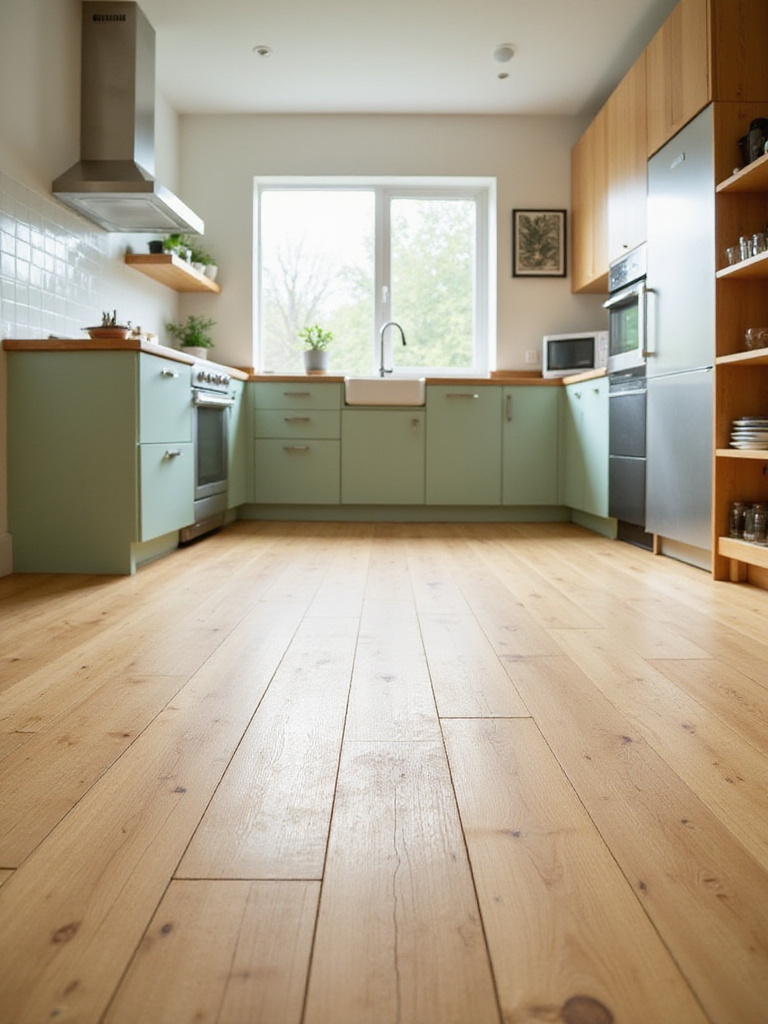
But is bamboo durable enough for busy kitchens? Absolutely – especially strand-woven bamboo, which often exceeds the hardness of many hardwoods, making it highly resistant to scratches and dents. It comes in various styles and finishes too, from horizontal and vertical to strand-woven, each with unique grain patterns. Finishes range from natural and light to dark and stained, allowing for perfect customization in your green kitchen design.
Let me paint you a picture… light, natural bamboo flooring creates a bright, airy kitchen space that feels clean and modern while silently communicating your commitment to sustainability with every step.
6. Maximize Natural Light
Natural light transforms any green kitchen design, creating both aesthetic appeal and energy savings. It enhances colors and textures, making your kitchen feel more open and inviting. Studies show natural light improves mood, productivity, and overall well-being – plus it significantly reduces the need for artificial lighting, directly lowering energy consumption and electricity bills.

Several architectural elements can help maximize daylight. Large windows, skylights, and glass doors are primary solutions, with placement carefully considered based on orientation. South-facing windows generally provide consistent sunlight, while east-facing windows offer bright morning light. Light shelves can bounce sunlight deeper into the room, while open floor plans facilitate light flow throughout the space.
The potential here is enormous – daylighting practices can reduce energy costs by as much as 75% during peak hours, making it a cornerstone strategy in effective green kitchen design.
7. Cultivate an Indoor Garden
What could be greener than bringing nature directly into your kitchen? A mini indoor garden adds life, freshness, and vibrant green to your space. Herbs like basil, mint, parsley, chives, oregano, rosemary, and thyme are excellent choices – they’re commonly used in cooking and relatively easy to grow indoors. For plants, consider pothos, snake plants, spider plants, or even small dwarf citrus trees if you have ample sunlight.

Most herbs and plants need at least 6 hours of sunlight daily, so a south-facing window is ideal. If natural light is limited, grow lights work well too. Proper drainage is essential – use pots with drainage holes and well-draining potting mix. Get creative with placement! Window boxes, hanging planters, vertical wall gardens, or dedicated shelf space all work beautifully in green kitchen design.
The missing piece is often just getting started – begin with 2-3 herbs you use frequently and watch how quickly your kitchen transforms into a living, breathing space.
8. Start Kitchen Composting
Food waste is a significant environmental issue, and kitchen composting addresses it right in your own home. Composting dramatically reduces food waste, diverting scraps from landfills where they produce methane, a potent greenhouse gas. Instead, you create nutrient-rich compost for your garden, reducing the need for chemical fertilizers – a win-win for the environment and your plants!

A wide variety of food scraps can be composted. Aim for a balance of ‘greens’ (nitrogen-rich items like fruit and vegetable scraps, coffee grounds, tea bags, and eggshells) and ‘browns’ (carbon-rich items like dried leaves, shredded newspaper, cardboard, and paper towels). The type of composter you choose depends on your space and lifestyle – countertop bins, vermicomposting systems, and Bokashi buckets all offer different advantages.
“Food waste makes up over 20% of landfill volume. Composting in your green kitchen design isn’t just about sustainability – it’s about taking responsibility for the full lifecycle of our food.”
9. Create a Recycling Station
A dedicated recycling station is essential for managing recyclables effectively in any green kitchen design. It simplifies sorting, making recycling more convenient and encouraging consistent habits. This directly reduces landfill waste while keeping your kitchen cleaner and more organized by preventing recyclables from piling up haphazardly.

When designing your station, consider available space, commonly recycled materials, and local guidelines. Decide on the number and size of bins needed, and how accessible they’ll be for emptying. Make the station user-friendly with clear labels for each bin (glass, plastic, paper) and consider color-coding for quick identification. Place it in a convenient location, ideally near your food prep area, and ensure bins are easy to clean and empty.
It works something like this… a pull-out drawer system within a kitchen island or cabinet conceals bins while keeping them accessible – maintaining the sleek aesthetic of your green kitchen design while supporting daily sustainable habits.
10. Use Low-VOC Paints and Finishes
Creating a green kitchen design means considering not just visible elements but also the air you breathe. VOCs (Volatile Organic Compounds) evaporate at room temperature from paints, finishes, and adhesives, contributing to indoor air pollution and causing respiratory irritation, headaches, and potentially long-term health problems. In kitchens, where cooking fumes already exist, VOCs can worsen air quality issues.

Look for low-VOC paints (less than 50 grams of VOCs per liter) or zero-VOC options (less than 5 grams per liter). Options include latex paints, acrylic paints, milk paints, clay paints, and mineral paints. For finishes, consider water-based polyurethane, shellac, or natural oils labeled as low-VOC. Identify these products through certifications like Green Seal, GREENGUARD Gold, and Declare Label on packaging.
The surprising part is how these healthier options have evolved – today’s low-VOC products offer performance comparable to conventional options while supporting the healthier indoor environment essential to green kitchen design.
11. Choose Bamboo Cabinetry
Cabinetry is a major component of any kitchen, and bamboo offers a modern aesthetic with strong eco-credentials for green kitchen design. As a rapidly renewable resource growing in just 3-5 years versus decades for traditional trees, bamboo reduces deforestation and allows for quicker resource replenishment. It also requires less water and pesticides compared to other materials.

Aesthetically, bamboo offers a sleek look with unique grain patterns that can be stained or finished in various colors to suit different styles. Its natural warmth and light color brighten kitchen spaces, while accepting stains and finishes well for customization. Properly manufactured bamboo cabinets are surprisingly strong and durable, often comparable to hardwoods like maple, though quality and construction methods are crucial for longevity.
My discovery began when I realized bamboo isn’t technically wood at all – it’s a grass, which contributes to its rapid growth rate and makes it an innovative alternative for sustainable green kitchen design.
12. Install LED Lighting
Lighting is essential for both function and ambiance in green kitchen design. LEDs are significantly more energy-efficient than traditional options, using up to 75% less electricity than incandescent bulbs while lasting up to 25 times longer. This means lower energy bills and less frequent replacements. They also produce minimal heat, making kitchens more comfortable, while offering various color temperatures to customize ambiance.

Different kitchen areas benefit from specific LED applications. Recessed spotlights provide general ambient lighting, under-cabinet strips deliver focused task lighting for countertops, pendant lights create focal points above islands, track lighting offers flexible direction, and dimmable bulbs allow brightness adjustments for different activities. Combining these types optimizes illumination throughout your green kitchen design.
Let’s unpack this… LEDs weren’t always so versatile – they were first invented in the 1960s but only available in red. It took decades to develop other colors, including the white light we now take for granted in our homes.
13. Create Upcycled Kitchen Decor
Upcycling offers a fantastic way to add unique character to your green kitchen design while being eco-conscious. It reduces waste, minimizes demand for new production, and adds personality to your space. It’s budget-friendly, allows for personalization, and creates conversation pieces reflecting your sustainability commitment.

The possibilities for upcycling are endless! Consider repurposing old wooden crates, mason jars, glass bottles, vintage silverware, reclaimed wood, metal containers, ladders, or even old doors. The key is looking beyond original purpose to envision something new. Just ensure items are thoroughly cleaned, use food-safe finishes, address any sharp edges, consult professionals for electrical items, and consider weight and stability for hanging pieces.
- Turn mason jars into stylish spice storage
- Transform wooden crates into open shelving
- Repurpose vintage silverware as unique hooks
- Convert glass bottles into pendant lights
- Use old doors as pantry entrances
14. Choose Durable Materials
Selecting durable materials is fundamental to green kitchen design. Long-lasting materials significantly reduce waste by minimizing replacements and repairs, lowering environmental impact from manufacturing, transportation, and disposal. They often require less maintenance, saving resources like water and cleaning products over their lifespan.

For countertops, consider recycled glass, quartz, solid surface materials with recycled content, responsibly sourced butcher block, or stainless steel. For cabinets, look for solid wood construction, high-quality hardware, durable finishes resistant to scratches and moisture, and proper professional installation. Reclaimed wood offers another durable and sustainable cabinet option for green kitchen design.
You might be wondering if durability always means higher cost – while initial investment may be greater, the long-term savings in both environmental impact and replacement costs make durable materials the more economical choice over time.
15. Design Smart Storage
Smart storage is essential for a functional green kitchen design. Effective storage minimizes food waste by improving organization and visibility, reducing spoilage and impulse purchases. It also reduces material waste by encouraging reusable containers, lessening reliance on single-use plastics, and facilitating proper recycling.
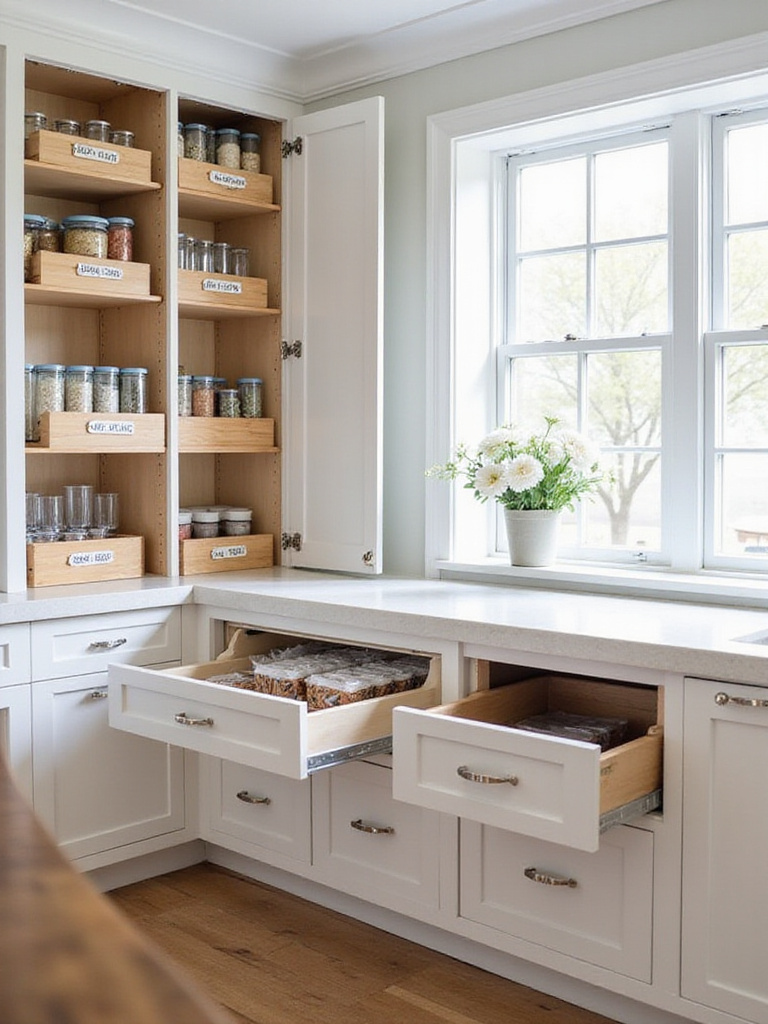
Maximize vertical space with pull-out shelves and drawers. Incorporate specialized storage for different foods, use transparent containers for visibility, and create designated recycling and composting stations. Consider the ‘first in, first out’ (FIFO) principle when arranging shelves. Choose sustainable, non-toxic materials like bamboo, glass, stainless steel, recycled plastic (BPA-free), and FSC-certified sustainable wood.
The ripple effects are enormous – Americans waste approximately 40% of their food, contributing significantly to landfill waste and greenhouse gas emissions. Smart storage in your green kitchen design can dramatically reduce this percentage in your home.
16. Pursue Green Building Certifications
For a comprehensive approach to green kitchen design, consider pursuing certifications like LEED (Leadership in Energy and Environmental Design). This globally recognized rating system provides a framework for creating healthy, efficient, and cost-saving green buildings, encouraging sustainable materials, energy-efficient appliances, water-saving fixtures, and healthy indoor air quality.

LEED principles apply to materials and resources, energy efficiency, water efficiency, indoor environmental quality, location and transportation, and innovative design. Unlike simply using ‘green’ products, LEED certification is a systematic approach requiring documentation, verification, and adherence to performance standards across multiple categories, considering the entire building lifecycle with independent verification.
The breakthrough came when homeowners realized certification isn’t just for commercial buildings – consulting with a LEED Accredited Professional early in the design process can help achieve certification even for residential green kitchen design projects.
17. Incorporate Vintage Elements
Injecting vintage and antique pieces into your green kitchen design adds charm while contributing to sustainability. It repurposes existing materials, preventing landfill waste and reducing demand for new production. Vintage pieces were often made with higher quality materials and craftsmanship, ensuring longevity and reducing replacements.

These elements add character, warmth, and history, providing a unique touch that modern items can’t replicate. Consider repurposed dressers as islands, antique hutches, vintage hardware, restored appliances (ensuring energy efficiency), vintage décor like canisters and scales, antique pendant lighting, or vintage sinks and faucets to enhance your green kitchen design.
The stumbling block is finding the right balance – many vintage kitchen appliances, while beautiful, weren’t designed with energy efficiency in mind. Research energy-saving modifications or consider using particularly inefficient pieces purely for decoration rather than daily use.
18. Create a Sustainable Backsplash
The backsplash is prime real estate to showcase sustainable style in green kitchen design. Recycled tiles and natural stone offer environmental benefits by reducing landfill waste, conserving resources, and lowering carbon footprints. Stylistically, they add unique character, texture, and visual interest – recycled tiles in diverse colors and patterns, natural stone with timeless luxury.

Options include recycled glass, ceramic, metal, or plastic tiles, while natural stone choices range from granite and marble to slate, travertine, and limestone. Combine them creatively – use natural stone as a border or accent to recycled tiles, create mixed material mosaics, or use stone as a focal point behind the stove surrounded by recycled tiles. Just ensure colors and textures complement each other for a cohesive look in your green kitchen design.
Picture it this way… a mosaic backsplash using broken recycled tiles and natural stone pebbles creates an artistic focal point that’s not just beautiful but tells a story of materials given new life and purpose.
19. Embrace Open Shelving
Open shelving is both aesthetically pleasing and eco-friendly in green kitchen design. It reduces material usage in cabinetry construction, minimizing wood or composite materials needed for doors, frames, and hardware. It also encourages a minimalist approach, prompting decluttering and keeping only essential items, reducing unnecessary consumption.

Aesthetically, open shelving creates a light, airy feel, making kitchens appear larger and more inviting. It showcases personality by displaying beautiful kitchenware, plants, and décor while enhancing natural light, reducing artificial lighting needs. To manage potential drawbacks like dust, clean regularly and use shelf liners. For organization, group similar items, use baskets, avoid overcrowding, and choose complementary colors and materials.
This changes everything, doesn’t it? The minimalist aesthetic of open shelving in green kitchen design encourages more mindful consumption and a less cluttered lifestyle – a design choice that actually shapes behavior.
20. Use Eco-Friendly Cleaning Products
Maintaining a green kitchen design extends beyond materials to cleaning practices. Conventional products often contain harsh chemicals harmful to health and the environment, while eco-friendly alternatives use plant-based or mineral-based ingredients that are biodegradable, non-toxic, and safer for you and the planet.

Avoid ingredients like ammonia, chlorine bleach, phthalates, triclosan, parabens, phosphates, SLS/SLES, and VOCs, which have negative health and environmental effects. Instead, try DIY solutions like water and vinegar for all-purpose cleaning, plant-based dish soap, baking soda paste for oven cleaning, baking soda and vinegar for drains, and water and vinegar for glass cleaning.
Do you see how huge that is? Vinegar isn’t just for salad dressing – it’s a natural disinfectant and deodorizer, making it a powerful cleaning agent that completes your green kitchen design journey by ensuring maintenance is as sustainable as the design itself.
Conclusion
Designing a stunning green kitchen is an exciting journey that blends beauty with responsibility. By embracing these 20 eco-friendly ideas, you create a space that’s not only gorgeous and functional but also reflects your commitment to sustainability.
From calming earthy green paint to durable bamboo flooring and unique recycled glass countertops, each choice contributes to a healthier home and planet. Energy-efficient appliances, water-saving fixtures, smart storage, and eco-friendly cleaning products minimize environmental impact while maximizing charm and efficiency.
Take these ideas and let your creativity flourish as you design your own stunning green kitchen – a space where sustainability and style blend harmoniously to create the heart of your eco-conscious home.

